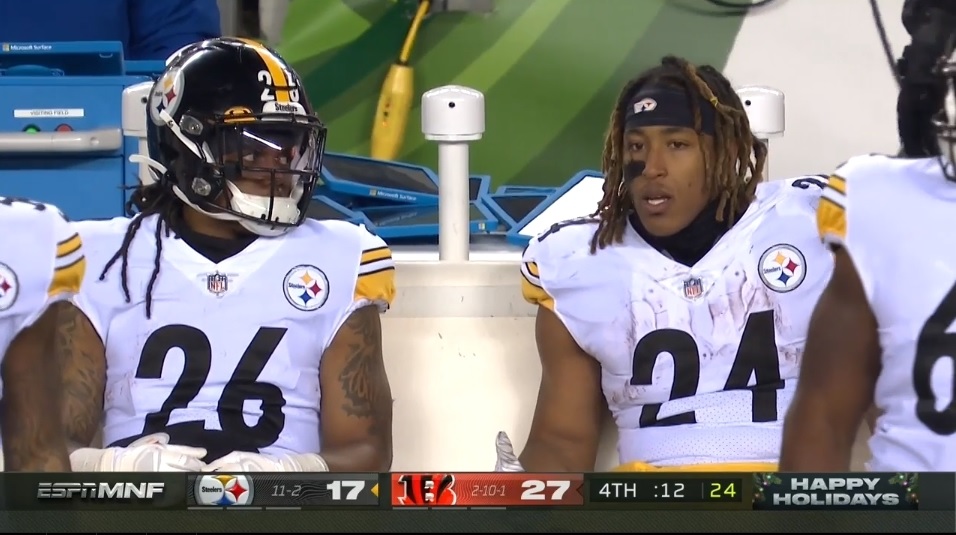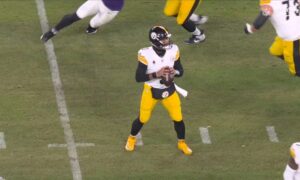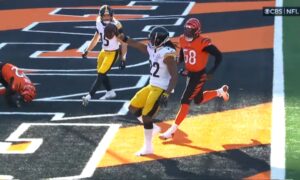After the Steelers selected RB Najee Harris with the 24th selection in the first round of the 2021 NFL Draft, many assumed that the Alabama product would step in to the feature back role from the get-go. While this is the expectation for both those in the building in Pittsburgh and members of the national media, the question remains how the rest of the depth chart is slated to shake out heading into the 2021 season. I have taken the liberty to look at the potential options on the depth chart currently behind Najee Harris and take a stab at who may be the most impactful reserve at running back for Pittsburgh.
Benny Snell (5’10, 224lb)
Benny Snell was drafted in the fourth round back in 2019 to serve as a backup to James Conner and provide and impact on special teams and be a short-yardage specialist that can push the line and pick up the tough yardage in-between the tackles. For the most part, Snell has filled this role well, especially when in the red zone. Here is an example from the Bengals game last season where Snell successfully punches it in from the goal line, plunging in for the score by using his size and power to get through.
He is a back that appears to get better as the game goes on, wearing on opposing defenses and becoming a chore to tackle. He runs behind his pads well and can be the aggressor as a runner, looking to dish out punishment of his own as we see here on this nasty stiff arm against Marcus Peters.
While a nice highlight, you do see Snell lose his footing and slip, thus limiting his chance of turning the play into a much bigger gain. While a fairly successful bruiser, Snell tends to struggle when having to create for himself outside of what is blocked for him. Here against Cincinnati, we watch Snell get the hand off in a short-yardage situation, but improperly reads the hole opening up to the left, running straight into the linebacker coming downhill for a loss on the play. Would Snell have executed a jump cut to the left, he would have had enough green grass to pick up first down yardage.
While he has provided value on special teams his first two seasons, Snell has failed to provide any significant impact as a receiver out of the backfield. His run success rate decreased with porous offensive line play due to his lack of vision and ability to create for himself, but also to the fact that his lack of burst and speed, recording a subpar 4.66 40-yard dash at the NFL Combine. Overall, Snell is a runner that can get what is blocked for him and be useful on the goal line, but the rest of his game is fairly limited due to lack of upside. For instance, 23% of his rushes last season went for zero or negative yardage.
Anthony McFarland Jr. (5’8, 208lb)
Another recent fourth round selection by Pittsburgh, McFarland had a pretty quiet 2020 campaign as a rookie, tallying only 33 attempts for 113 yards (3.4 YPC) along with six receptions for 54 yards. Being a Redshirt Sophomore coming out of Maryland with little playing experience during a pandemic-impacted offseason likely had some effect on his development, as he likely needed more time to acclimate to the speed of the NFL game and earn the trust of coaches in passing down situations as a receiver and pass protector. There is no denying that McFarland is in a different mold than your typical Steelers running back, weight sub-200lb and lacking the size and thickness of a traditional power back. While not a complete liability in-between the tackles, McFarland shouldn’t be seen as a feature back with the strength and power to routinely break through tackles as you can see on this example against the Texans where he gets stuffed on the short-yardage play on third down.
However, McFarland brings speed and explosiveness to the backfield that the team has been sorely missing for years. He regularly displayed the ability as a big-play threat in college with the Terrapins, and we got to see glimpses of that during his rookie campaign like on this play against Houston where burn the angle of pursuit from the linebacker after getting the handoff from the shotgun, bursting to the 2nd level for a big gain on second down.
Another example here against Washington where McFarland gets the handoff on the draw and sprints to the left, making the safety coming downhill hesitate and nearly gets the angle on him on the nice nine-yard pickup.
While he only has a limited sample size as a receiver, McFarland showed he can be a weapon in this facet of the game as well thanks to his speed and his playmaking ability in the open field. He isn’t the shiftiest back, but he does possess the ability to make quick jump cuts or have stop/start quickness to decelerate and reaccelerate to fake out would be tacklers. This can make him a mismatch in coverage for bigger, less agile linebackers. We see on this catch versus Dallas McFarland bring in the reception and run to the sideline but decelerates by putting his foot into the ground to cut back inside, making #55 Leighton Vander Esch completely overrun him.
Kalen Ballage (6’1, 228lb)
Ballage is a HWS specimen who hasn’t put it all together since coming into the league from Arizona State in 2018, but he does have the open field juice that Benny Snell lacks in terms of speed and explosiveness. He ran a 4.46 40-yard dash at the NFL Combine, and while his lack of vision and field awareness has played a detriment in showcasing this speed, Ballage has had instances where this athleticism shows up on film, mainly his 75-yard TD run against the Vikings below where he gets in space and breaks away from the entire defense for the long score.
He also has statistically been very effective in short-yardage situations as highlighted by Alex Kozora after the signing, converting 18/24 attempts on third or fourth down with 1-2 yards to go for a 75% success rate. For comparison, Snell has a 56.3% success rate in the same short-yardage situations during the same time frame. Here on this example vs the Raiders last season, we see Ballage execute a good jump cut to the left, get up field with burst and put his shoulder into the safety coming up to tackle him, bulldozing him over for extra yardage on the chunk play.
Overall, though, Ballage is mainly a straight-line runner that doesn’t have a lot of consistency in his lateral movement skills and feel for changing directions quickly. Here we see him take the handoff to the left side of the formation and put his foot in the ground to cut upfield, avoiding the ankle tackle and keeping his balance to get a few extra yards at the end of the run.
As mentioned earlier, Ballage is a physically gifted back, but his game has a lot of inconsistencies. His vision is poor, leading to a bad YPC average throughout his NFL career. He also has been utilized in the passing game, but as seen in the clip below, he isn’t the most natural receiver out of the backfield.
All that being said, Ballage does provide some intrigue as a successful short-yardage back, having the fifth-best success rate in the league the last two seasons (minimum 24 attempts via Alex Kozora’s article) along with the potential to rip off big chunk plays on the ground and provide special teams value on kick and punt coverage units. The number of hats he can wear will give him value and a chance to continue behind Harris.
The Verdict
If I were a betting man, I would give the nod to Anthony McFarland Jr. to be the primary second option to Najee Harris in the ground game in 2021. McFarland provides a different skill set than both Snell and Ballage as a speedy scat back that has been utilized in a Matt Canada offensive system in the past with great success as a runner creating big chunk plays on zone concepts and misdirection thanks to pre-snap motion. Snell and Ballage may fit the role of more of a traditional sized power back, but unless Najee Harris gets injured or needs an extended breather, he is the back you are going to want to have in on short-yardage and goal line situations. While Harris is also a good receiver out of the backfield, McFarland can serve as that change-of-pace back, challenging defenses on the edges, draws, and in the screen/short passing game after Harris has worn the opposing defense down. When McFarland came out last season, I stated that I saw some Devonta Freeman to his game as a guy that can provide a spark to an offense with a traditional power back in front of him. In the case of Pittsburgh, I would say that McFarland can fill a similar role to that of Mewelde Moore for his time with the Steelers, being the Robin to Najee Harris’ Batman as an effective and potentially deadly combination of “Thunder and Lightning” in OC Matt Canada’s offensive system.
What are your thoughts on the depth chart behind Najee Harris? Do you agree that McFarland should be the favorite to have a role behind the likely rookie starter, or should one of the other guys get the nod? Please comment below and thanks again for reading!








